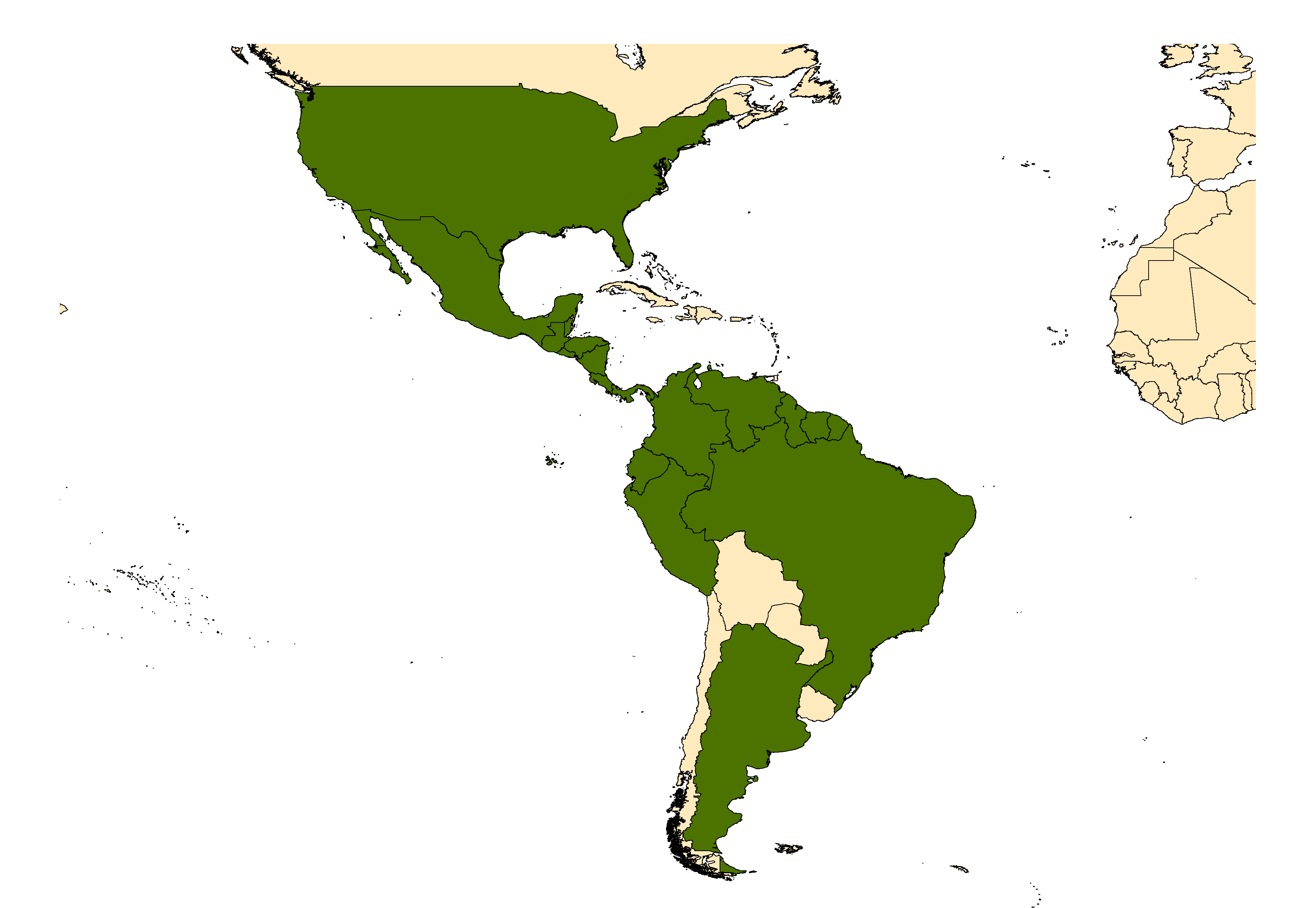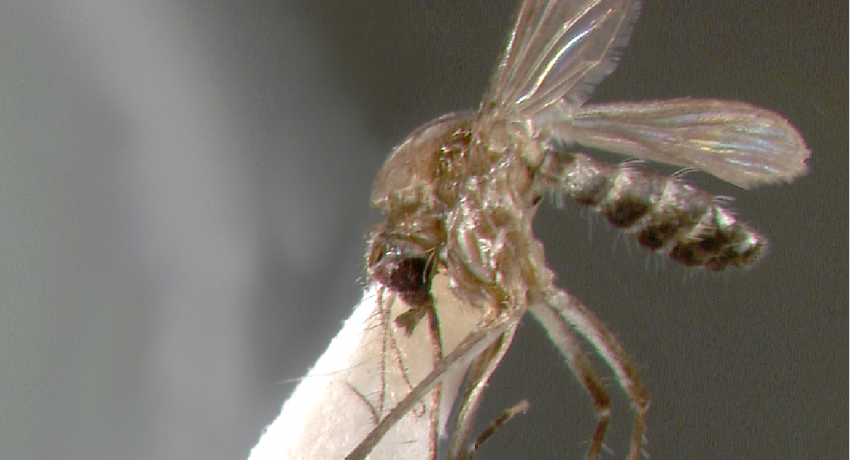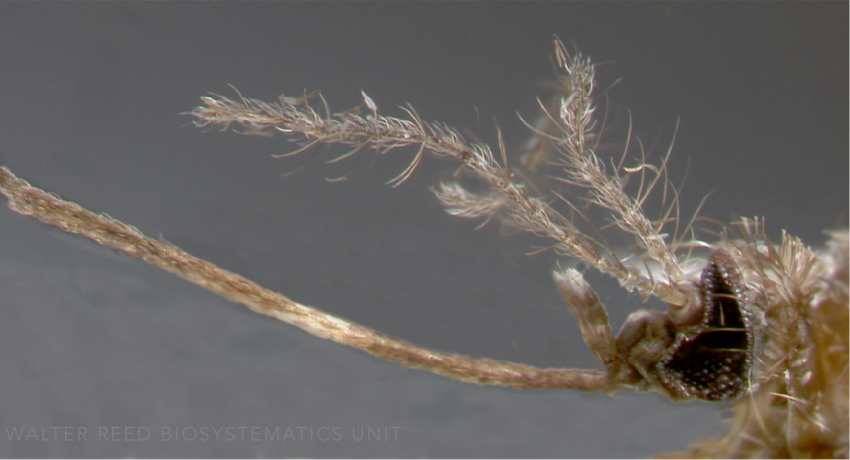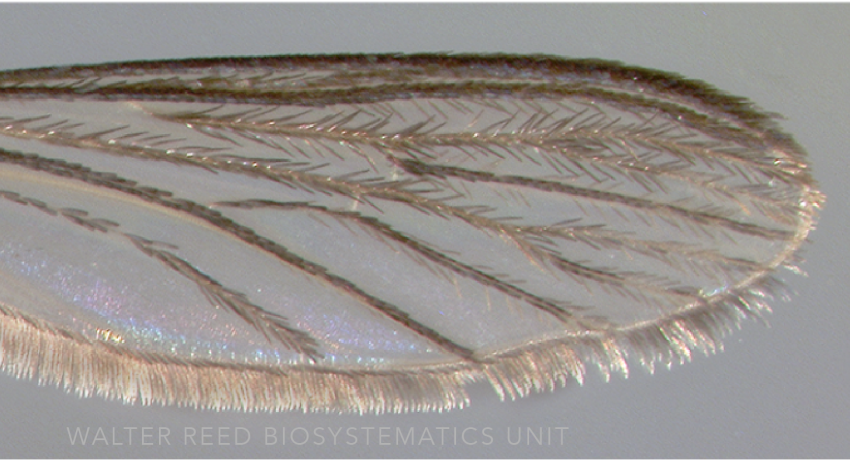NEARCTIC & NEOTROPICAL REGIONS
Etymology: banded beak (Gr); white bands on a black proboscis
Aedes taeniorhynchus is a relatively small New World salt marsh Aedes, with white-tipped palps and distinctive banding on its proboscis, abdomen and tarsi. Although most specimens of Ae. taeniorhynchus sport a broad median white band on the proboscis, these bands were notably absent in around 10% of samples collected in Virginia and North Carolina. Specimens from Jamaica and other Antillean islands are also considerably darker than typical examplars, and these morphological differences could denote the presence of hidden biodiversity. Aedes taeniorhynchus belongs to the Culicelsa Group, together with Ae. mitchellae (Dyar), Ae. nigromaculis (Ludlow) and Ae. sollicitans (Walker). It has five valid synonyms: damnosus Say from the United States, niger Giles from Antigua, portoricensis Ludlow from Puerto Rico, epinolus Dyar & Knab from Peru, and pix Martini from Belize.
Type locality: Mexico
Type depository: Naturhistorisches Museum, Vienna, Austria (NMW)
DIAGNOSTIC CHARACTERS (Click photos to view; mouse over and click large photo to zoom in.)
ADULT (illustrated): Head: Proboscis with broad, median pale band. Thorax: Postprocoxal membrane bare. Leg: Fe-I and Ti-I all dark; Ta-III1 without median white band; Ta-III1–5 with basal white bands. Abdomen: Terga (Te) with basal pale bands, without central spots or median stripe. Wing: All dark-scaled.
LARVA (not illustrated): Head: Setae 5,6-C single, gradually tapering. Terminal segments: Comb scales rounded apically, 9-20 in irregular patch; seta 1-VIII at least 0.5 as long as siphon; siphon about as wide as segment X; seta 1-S inserted beyond pecten; saddle complete with many posterior spicules; anal papillae shorter than segment X, without tracheae; seta 2-X with ≥6 strong branches, distinctly shorter than 3-X.
TAXONOMIC KEYS
Dodge 1966
Bohart & Washino 1978
Darsie & Ward 2005
Becker et al. 2010
Harrison et al. 2016
![]()
WRBU – Aedes – Neotropical Region – Larva
Exemplar DNA sequences
Ae. taeniorhynchus : JX259676, KT766538–47, MG242518, KY859919–20
BIONOMICS
Immatures
Females deposit their eggs in the open at the muddy bases of vegetation in salt marshes and mangroves, where immatures raise in the slightly brackish floodwater pools after heavy rains. In Jamaica, Ae. taeniorhynchus have been collected in large crabholes and in irrigation channels.
Adults
High densities of Ae. taeniorhynchus are linked to periods of heavy rainfall and high tides in the mid and late summer. In northern populations, the species overwinters as egg, but the population is present year-round in the South of its range. Mating occurs in swarms close to the emergence sites, and female Ae. taeniorhynchus feed predominantly on large mammals, including cattle and man. Although peak biting times are crepuscular, this species is highly aggressive and will feed at any time of the day—even in bright sunlight. Even in windy conditions, females are very strong flyers and will undertake flights of up to 30km to search for suitable hosts, or other suitable oviposition sites (such as brackish water pools in oil fields), often many miles from the coast. Their propensity for high density populations and their aggressive biting behavior renders them a nuisance pest in many parts of the Southern United States, and in coastal regions of the Caribbean islands.
DISTRIBUTION NOTES
Anguilla, Antigua & Barbuda, Argentina, Bahamas, Barbuda, Barbados, Belize, Bermuda, Brazil, Cayman Islands, Colombia, Costa Rica, Cuba, Curacao, Dominica, Dominican Republic, Ecuador, El Salvador, French Guiana, Grenada, Guadeloupe, Guatemala, Guyana, Haiti, Honduras, Jamaica, Martinique, Mexico, Montserrat, Nicaragua, Panama, Peru, Puerto Rico, Saba, Saint Kitts & Nevis, Saint Lucia, St Vincent & the Grenadines Suriname, Trinidad & Tobago, United States (continental), Venezuela, Virgin Islands.

WRBU VECTOR HAZARD REPORTS
VHR: Mosquitoes of the Caribbean
View other WRBU Vector Hazard Reports
Available GIS Models
Ae_taeniorhynchus_Dornak_1 South & Central America
IMPORTANT REFERENCES (full citations below)
Wiedemann 1821: 43 (A; as Culex)
Mitchell 1907 (E*)
Howard et al. 1913 (1912) (E*)
Howard et al. 1917: 667 (M*, F, L, E*; bionomics)
Gerry 1932: 39 (F*)
Gjullin 1937: 256 (F*)
Darsie 1951: 16 (P*)
Yamaguti & LaCasse 1951d: 198 (M*, F*, L*)
Lane 1953: 678 (M*, F, L*)
Nielsen & Nielsen 1953: 141 (bionomics)
Bohart 1954: 365 (L*)
Carpenter & LaCasse 1955: 238 (M*, F*, L*)
Craig 1956 (E*)
Forattini 1958: 176 (P*)
Craig & Horsfall 1960 (E*)
Dodge 1966: 358 (1st instar L*; key)
Myers 1967 (E*)
Belkin et al. 1970: 152 (M*, F, P*, L*)
Bohart & Washino 1978: 118 (M, F*, L*; keys, taxonomy, bionomics, distribution)
Scotton & Axtell 1979 (E*)
Darsie & Ward 2005 (F*, L*; keys, distribution)
Becker et al. 2010: 393 (F*, L*; key, taxonomy, distribution, bionomics)
Marcondes et al. 2012 (E*)
Harrison et al. 2016 (F*, L*; keys, distribution; see note 4)
CURRENT SYNONYMS
syn. damnosus Say
1823: 11 (A; Culex). Type locality: Pennsylvania, United States (NE).
syn. niger Giles
1904b: 384 (F; Taeniorhynchus). Type locality: Antigua Island [Lesser Antilles] (NHMUK). References: Belkin 1968b: 6 (lectotype designation).
syn. portoricensis Ludlow
1905c: 386 (F; Culex). Type locality: San Juan, Puerto Rico (USNM). References: Stone & Knight 1956a: 224 (type info., lectotype designation).
syn. epinolus Dyar & Knab
1914: 61 (F). Type locality: Ventanillas, Peru (USNM). References: Stone & Knight 1956a: 217 (type info., lectotype designation).
syn. pix Martini
1935: 55 (F). Type locality: Belize, British Honduras (USNM). References: Lane 1953: 652 (F); Mattingly 1955c: 29 (type information); Stone & Knight 1956a: 224 (type information); Stone & Knight 1956a: 224 (type information); Heinemann & Belkin 1977d (synonymy).
CITED REFERENCES
Becker, N., Petrić, D., Zgomba, M., Boase, C., Madon, M., Dahl, C., & Kaiser, A. (2010). Mosquitoes and their control (Second ed.). Berlin Heidelberg: Springer-Verlag.
Belkin, J.N. (1968b). Mosquito studies (Diptera, Culicidae). IX. The type specimens of New World mosquitoes in European museums. Contributions of the American Entomological Institute, 3(4), 1–69.
Belkin, J.N., Heinemann, S.J., & Page, W.A. (1970). The Culicidae of Jamaica (Mosquito studies. XXI) Contributions of the American Entomological Institute, 6(1), 458.
Bohart, R.M. (1954). Identification of first stage larvae of California Aedes (Diptera, Culicidae). Annals of the Entomological Society of America, 47(2), 355–366.
Bohart, R.M. & Washino, R.K. (1978). Mosquitoes of California (3rd ed.). Berkeley, CA: University of California, Agriculture and Natural Resources.
Carpenter, S.J., & LaCasse, W.J. (1955). Mosquitoes of North America (North of Mexico). Berkeley, Los Angeles: University of California Press.
Craig Jr., G.B. (1956). Classification of eggs of nearctic Aedinae mosquitoes (Diptera: Culicidae). Dissertation Abstract (5).
Craig Jr., G.B., & Horsfall, W.R. (1960). Eggs of floodwater mosquitoes. VII. Species of Aedes common in the Southeastern United States (Diptera: Culicidae). Annals of the Entomological Society of America, 53(1), 11–18.
Darsie, R.F., Jr. (1951). Pupae of the culicine mosquitoes of the northeastern United States (Diptera, Culicidae, Culicini). Ithaca, NY: Cornell University Agricultural Experiment Station Memoir 304.
Darsie, R.F., Jr., & Ward, R.A. (2005). Identification and geographical distribution of the mosquitoes of North America, north of Mexico. Gainesville, FL: University Press of Florida.
Dodge, H. R. (1966). Studies on mosquito larvae II. The first-stage larvae of North American Culicidae and of world Anophelinae. Canadian Entomologist, 98, 337–393.
Dyar, H.G., & Knab, F. (1914). New mosquitoes from Peru (Diptera, Culicidae). Insecutor Inscitiae Menstruus, 2, 58–62.
Forattini, O.P. (1958). Culicidae que se criam em buracos de carangueijos (Diptera). Revista Brasileira de Biologia, 18, 175–179.
Gerry, B. I. (1932). Morphological studies of the female genitalia of Cuban mosquitoes. Annals of the Entomological Society of America, 25, 31–75.
Giles, G.M. (1904b). Notes on some collections of mosquitoes received from abroad. Journal of Tropical Medicine, 7, 381–384.
Gjullin, C.M. (1937). The female genitalia of the Aedes mosquitoes of the Pacific coast states. Proceedings of the Entomological Society of Washington, 39, 252–266.
Harrison, B.A., Byrd, B.D., Sither, C.B., & Whitt, P.B. (2016). The mosquitoes of the Mid-Atlantic Region: an identification guide (Vol. 1). Madison Heights, MI: Publishing XPress.
Horsfall, W.R., & Craig, G.B. Jr. (1956). Eggs of floodwater mosquitoes IV. Species of Aedes common in Illinois. (Diptera: Culicidae). Annals of the Entomological Society of America, 49(4), 368–374.
Howard, L.O., Dyar, H.G., & Knab, F. (1913). The mosquitoes of North and Central America and the West Indies. (Vol. II) (1912). Washington, D.C.: Carnegie Institution of Washington.
Howard, L.O., Dyar, H.G., & Knab, F. (1917). The mosquitoes of North and Central America and the West Indies. Systematic description. Part II. Carnegie Institute of Washington.
Lane, J. (1953). Neotropical Culicidae (Vols. I, II). São Paulo: University of São Paulo.
Ludlow, C.S. (1905c). Mosquito notes. IV. Canadian Entomologist, 37, 385–388.
Marcondes, C.B., Mueller, G.A., dos Santos-Mallet, J., Alencar, J., Sarmento, J. S., Dos Santos, C. B., & Rezende, H. R. (2012). Scanning electron microscopy of eggs of Ochlerotatus taeniorhynchus (Diptera: Culicidae, Aedini). Zootaxa (3509), 77–80.
Martini, E. (1935). Los mosquitos de Mexico. Departamento de Salubridad Pública, Boletínes Tecnicos, Serie A: Entomología Médica y Parasitologia.
Mattingly, P.F. (1955c). Mosquitoes (Diptera: Culicidae) from the Tropical Institute at Hamburg. Proceedings of the Royal Entomological Society (B), 24, 27–33.
Mitchell, E.G. (1907). The classification of the Culicidae. Canadian Entomologist, 198–201.
Myers, C.M. (1967). Identification and description of Aedes eggs from California and Nevada (Diptera: Culicidae). Canadian Entomologist, 99, 795–806.
Nielsen, E.T., & Nielsen., A.T. (1953). Field observations on the habits of Aedes taeniorhynchus. Ecology, 34, 141–156.
Say, T. (1823). Descriptions of dipterous insects of the United States. Journal of the Academy of Natural Sciences of Philadelphia, 3, 9–54.
Scotton, G.L., & Axtell, R.C. (1979). Aedes taeniorhynchus and Aedes sollicitans (Diptera, Culicidae) oviposition on coastal dredge spoil. Mosquito News, 39(1), 97–110.
Stone, A., & Knight, K.L. (1956a). Type specimens of mosquitoes in the United States National Museum. II. The genus Aedes (Diptera, Culicidae). Journal of the Washington Academy of Sciences, 46(7), 213–228.
Wiedemann, C.R.G. (1821). Diptera exotica, Pt. I (enlarged ed. Vol. I). Kiliae Edition, 43–50.
Yamaguti, S., & LaCasse, W.J. (1951d). Mosquito fauna of North America Part V – Genus Aedes. Office of the Surgeon, Headquarters, 8th Army, APO 343. United States. Office of the Surgeon-General. 207th Malaria Survey Detachment.
CITE THIS PAGE
Walter Reed Biosystematics Unit (Year). Aedes taeniorhynchus species page. Walter Reed Biosystematics Unit Website, http://wrbu.si.edu/vectorspecies/mosquitoes/taeniorhynchus, accessed on [date (e.g. 03 February 2020) when you last viewed the site].











































































































































































